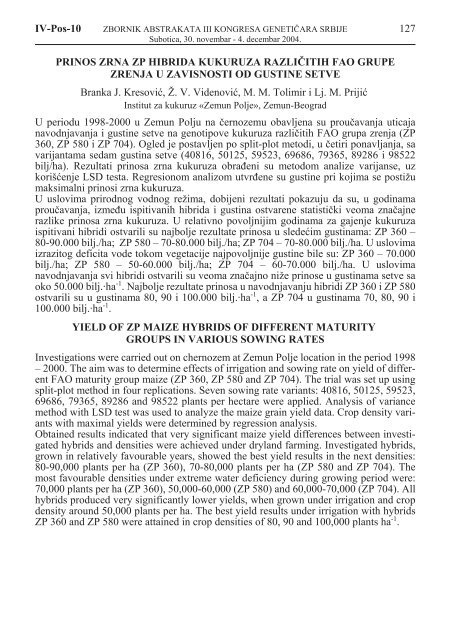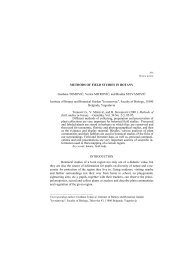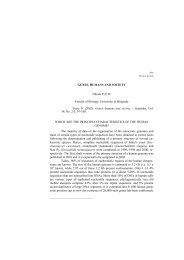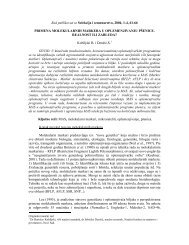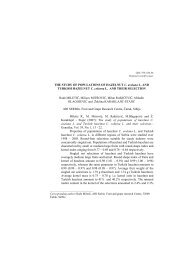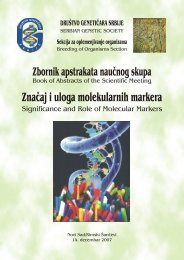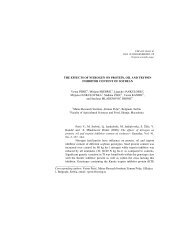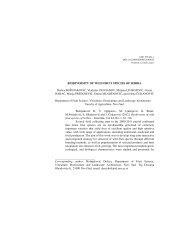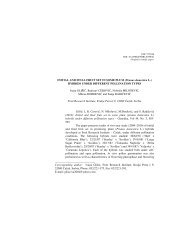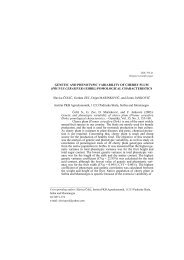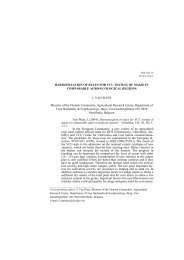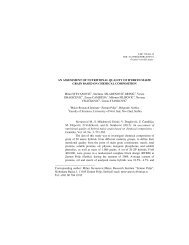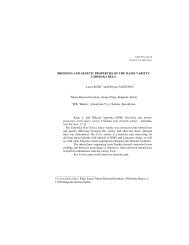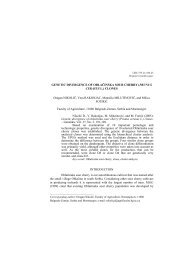Zbornik - Društvo genetičara Srbije
Zbornik - Društvo genetičara Srbije
Zbornik - Društvo genetičara Srbije
Create successful ePaper yourself
Turn your PDF publications into a flip-book with our unique Google optimized e-Paper software.
IV-Pos-10 ZBORNIK ABSTRAKATA III KONGRESA GENETIÈARA SRBIJE 127<br />
Subotica, 30. novembar - 4. decembar 2004.<br />
PRINOS ZRNA ZP HIBRIDA KUKURUZA RAZLIÈITIH FAO GRUPE<br />
ZRENJA U ZAVISNOSTI OD GUSTINE SETVE<br />
Branka J. Kresoviæ, . V. Videnoviæ, M. M. Tolimir i Lj. M. Prijiæ<br />
Institut za kukuruz «Zemun Polje», Zemun-Beograd<br />
U periodu 1998-2000 u Zemun Polju na èernozemu obavljena su prouèavanja uticaja<br />
navodnjavanja i gustine setve na genotipove kukuruza razlièitih FAO grupa zrenja (ZP<br />
360, ZP 580 i ZP 704). Ogled je postavljen po split-plot metodi, u èetiri ponavljanja, sa<br />
varijantama sedam gustina setve (40816, 50125, 59523, 69686, 79365, 89286 i 98522<br />
bilj/ha). Rezultati prinosa zrna kukuruza obraðeni su metodom analize varijanse, uz<br />
korišæenje LSD testa. Regresionom analizom utvrðene su gustine pri kojima se postiu<br />
maksimalni prinosi zrna kukuruza.<br />
U uslovima prirodnog vodnog reima, dobijeni rezultati pokazuju da su, u godinama<br />
prouèavanja, izmeðu ispitivanih hibrida i gustina ostvarene statistièki veoma znaèajne<br />
razlike prinosa zrna kukuruza. U relativno povoljnijim godinama za gajenje kukuruza<br />
ispitivani hibridi ostvarili su najbolje rezultate prinosa u sledeæim gustinama: ZP 360 –<br />
80-90.000 bilj./ha; ZP 580 – 70-80.000 bilj./ha; ZP 704 – 70-80.000 bilj./ha. U uslovima<br />
izrazitog deficita vode tokom vegetacije najpovoljnije gustine bile su: ZP 360 – 70.000<br />
bilj./ha; ZP 580 – 50-60.000 bilj./ha; ZP 704 – 60-70.000 bilj./ha. U uslovima<br />
navodnjavanja svi hibridi ostvarili su veoma znaèajno nie prinose u gustinama setve sa<br />
oko 50.000 bilj.·ha -1 . Najbolje rezultate prinosa u navodnjavanju hibridi ZP 360 i ZP 580<br />
ostvarili su u gustinama 80, 90 i 100.000 bilj.·ha -1 , a ZP 704 u gustinama 70, 80, 90 i<br />
100.000 bilj.·ha -1 .<br />
YIELD OF ZP MAIZE HYBRIDS OF DIFFERENT MATURITY<br />
GROUPS IN VARIOUS SOWING RATES<br />
Investigations were carried out on chernozem at Zemun Polje location in the period 1998<br />
– 2000. The aim was to determine effects of irrigation and sowing rate on yield of different<br />
FAO maturity group maize (ZP 360, ZP 580 and ZP 704). The trial was set up using<br />
split-plot method in four replications. Seven sowing rate variants: 40816, 50125, 59523,<br />
69686, 79365, 89286 and 98522 plants per hectare were applied. Analysis of variance<br />
method with LSD test was used to analyze the maize grain yield data. Crop density variants<br />
with maximal yields were determined by regression analysis.<br />
Obtained results indicated that very significant maize yield differences between investigated<br />
hybrids and densities were achieved under dryland farming. Investigated hybrids,<br />
grown in relatively favourable years, showed the best yield results in the next densities:<br />
80-90,000 plants per ha (ZP 360), 70-80,000 plants per ha (ZP 580 and ZP 704). The<br />
most favourable densities under extreme water deficiency during growing period were:<br />
70,000 plants per ha (ZP 360), 50,000-60,000 (ZP 580) and 60,000-70,000 (ZP 704). All<br />
hybrids produced very significantly lower yields, when grown under irrigation and crop<br />
density around 50,000 plants per ha. The best yield results under irrigation with hybrids<br />
ZP 360 and ZP 580 were attained in crop densities of 80, 90 and 100,000 plants ha -1 .


